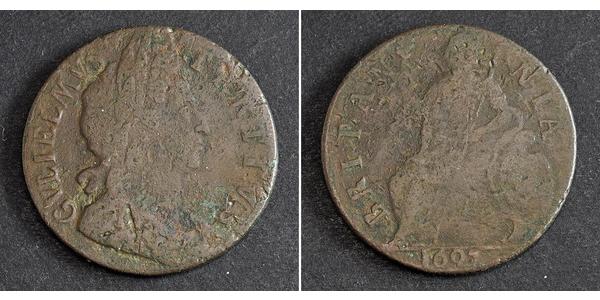(Vendue pour $4.0)
1697, Great Britain, William III. Copper 1/2 Penny Coin. Corroded/Damaged Fine!
Mint Year: 1697 Mint Place: London Denomination: ½ Penny Reference: KM-A483.1 ($50 in F!) Condition: Greenish deposits and corrosion scars, many small digs and scratches, otherwise Fine! Material: Copper Diameter: 28mm Weight: 9.09gm
Obverse: Wreathed bust of William III right. Legend: GVILELMVS TERTIVS Reverse: Britannia seated on globe left, holding olive-brancbh in right hand and shouldering spray. British shield behind her. Date (1697) below. Legend: BRITANNIA . / 1697
William III (William Henry; Dutch: Willem Hendrik; 4 November 1650 – 8 March 1702), also widely known as William of Orange, was sovereign Prince of Orange from birth, Stadtholder of Holland, Zeeland, Utrecht, Guelders, and Overijssel in the Dutch Republic from the 1670s and King of England, Ireland, and Scotland from 1689 until his death in 1702. As King of Scotland, he is known as William II. He is sometimes informally known as "King Billy" in Ireland and Scotland. His victory at the Battle of the Boyne in 1690 is commemorated by Unionists, who display orange colours in his honour. Popular histories usually refer to his joint reign with his wife, Queen Mary II, as that of William and Mary. William was the only child of William II, Prince of Orange, who died a week before his birth, and Mary, Princess of Orange, the daughter of Charles I of England, Scotland, and Ireland. In 1677, during the reign of his uncle Charles II of England, Scotland, and Ireland, he married his cousin Mary, the fifteen-year-old daughter of his maternal uncle James, Duke of York. A Protestant, William participated in several wars against the powerful Catholic king of France, Louis XIV, in coalition with both Protestant and Catholic powers in Europe. Many Protestants heralded him as a champion of their faith. In 1685, his Catholic uncle and father-in-law, James, became king of England, Scotland, and Ireland. James's reign was unpopular with the Protestant majority in Britain, who feared a revival of Catholicism. Supported by a group of influential British political and religious leaders, William invaded England in what became known as the Glorious Revolution. In 1688, he landed at the south-western English port of Brixham. Shortly afterwards, James was deposed. William's reputation as a staunch Protestant enabled him and his wife to take power. During the early years of his reign, William was occupied abroad with the Nine Years' War (1688–97), leaving Mary to govern the kingdom alone. She died in 1694. In 1696, the Jacobites plotted unsuccessfully to assassinate William and return his father-in-law to the throne. William's lack of children and the death in 1700 of his nephew Prince William, Duke of Gloucester, the son of his sister-in-law Anne, threatened the Protestant succession. The danger was averted by placing distant relatives, the Protestant Hanoverians, in line to the throne with the Act of Settlement 1701. Upon his death in 1702, the king was succeeded in Britain by Anne and as titular Prince of Orange by his cousin, John William Friso.
1 Grosh Pologne Cuivre Frédéric-Guillaume III de Prusse (177 ...
Le groupe a 2 pièces / 2 prix
⇑















